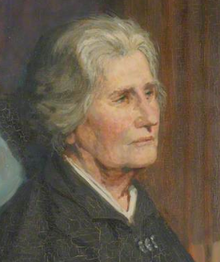Mary Paley Marshall
| Mary Paley Marshall | |
|---|---|

crop from painting by AS or SA
| |
| Born | 24 October 1850 Lincolnshire, England |
| Died | 19 March 1944 |
| Nationality | British |
| Alma mater | Cambridge University |
| Occupation | Economist |
| Employer | University College, Bristol, Oxford, The Marshall Library of Economics |
| Known for | One of the first women to study at Cambridge University. |
| Alfred Marshall | |
Mary Marshall (24 October 1850 – 19 March 1944), née Paley, was an economist and one of the first women to take the Tripos examination and to study at Newnham College as part of Cambridge University.
Childhood
Paley was born in Lincolnshire, England, a daughter of Rev. Thomas Paley, Rector of Ufford, and a great-granddaughter of the eighteenth-century theologian and philosopher William Paley. Mary Paley grew up in a rose-covered country rectory in Northamptonshire, England.
Education
She was educated at home, excelling in languages: in 1871, after performing well in rigorous entrance exams, she earned a scholarship to become one of the first five students at the recently founded Newnham College in Cambridge. She took the Moral Sciences Tripos in 1874, and was classed between a first and second-class, though as a woman she was debarred from graduation. Paley sat the exam with Amy Bulley. They were some of the first women to take tripos examinations and they sat the exams in Marion and Benjamin Hall Kennedy's drawing room. Paley described Professor Kennedy as excitable, but he would sometimes doze whilst invigilating. The only evidence she was given of her work was a confidential letter from her examiners. Women sitting the tripos examination was a milestone for Cambridge University and the importance can be gauged by the people involved. The people who delivered Paley and Bulley's papers were Alfred Marshall, Henry Sidgwick, John Venn and Sedley Taylor. Alfred Marshall's brilliant lectures on political economy inspired Mary and with his encouragement and help she took the university's final exams, which no woman had ever done before. She passed with honors, although unofficially, because for many years women were not permitted Cambridge or Oxford degrees.
Life
In 1875 Mary became Cambridge's first woman lecturer, teaching economics at Newnham College. She was an inspiring teacher who dressed like the women in the Pre-Raphaelite prints that decorated her room. Her students adored her. At the age of twenty-five Mary Paley was that rare thing in Victorian times, an unmarried woman who lived independently from her parents and earned a good living doing a job she loved.
In 1876, she became engaged to Alfred Marshall who had been her economics tutor, and was a strong supporter in higher education for women. In 1878 they moved to found the teaching of economics at University College, Bristol. In 1883 she followed him to Oxford, before the couple returned to Cambridge in 1885 where they built and moved into Balliol Croft, (renamed Marshall House in 1991). Mary lectured on economics herself, and was asked to develop a book from her Cambridge lectures. Mary and Alfred wrote The Economics of Industry together, published in 1879. Alfred disliked the book, however, and it eventually went out of print, even with moderate demand for it. Alfred had changed his mind about women students at Cambridge. He wrote pamphlets and letters objecting to a mixed university, and in 1897 a university law was passed preventing women from being given a Cambridge degree. This did not change until 1947, making it the last university in the UK to give women degrees.
Mary was loyal to Alfred and did not complain, but she kept on teaching and inspiring her women students at Newnham and Girton until 1916. She took up painting, revealing a hidden talent, and was an active worker for local charities.
Mary, a firm friend of Eleanor Sidgwick, kept up her association with Newnham College: she was an Associate from 1893 to 1912, twice (1891-4, 1907-9) a member of the College Council, and one of the original trustees of the Mary Anne Ewart Trust. However, her husband Alfred became increasingly obstructive to the cause of women's education, believing that women had nothing useful to say. When Cambridge began to consider giving women degrees, he forsook friendships and respect to go against the movement. Mary was nevertheless totally devoted to her husband, and an important unofficial collaborator in his own economic writings. Alfred's major theoretical work was Principles of Economics: he is mentioned as the only author, but Mary may have done quite as much work as he did on the book.
After her husband died in 1924, Mary became Honorary Librarian of The Marshall Library of Economics at Cambridge, to which she donated her husband's collection of articles and books on economics. She continued to live in Balliol Croft until her death in 1944. She passed away in the City of Cambridge, Cambridgeshire, England on 19 March 1944 at the age of 93. Her ashes were scattered in the garden. Her husband is buried in the Ascension Parish Burial Ground.
She was a member of the Ladies Dining Society in Cambridge, with eleven other members.
.
No hay comentarios:
Publicar un comentario